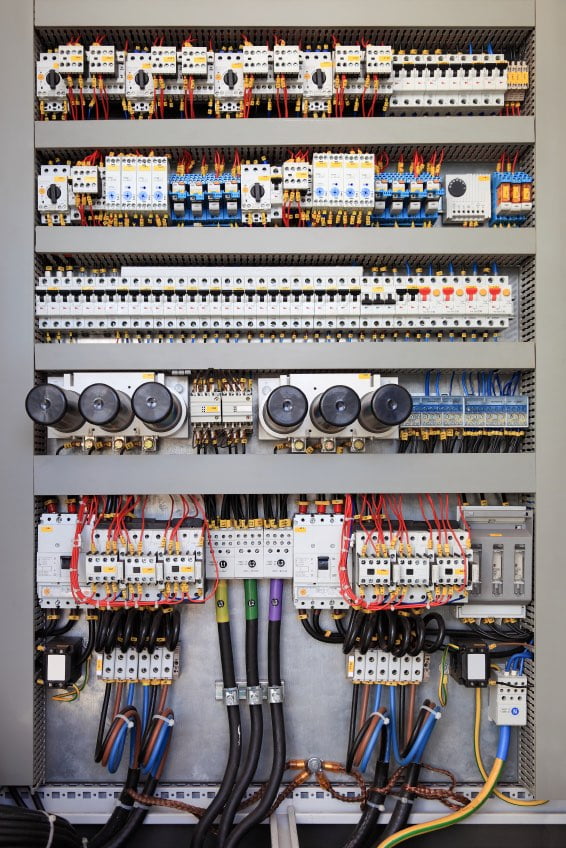6 Environmental Considerations for Industrial Control Panels

When selecting an industrial control panel, it’s essential to give careful consideration to the environment where the panel will be installed. The ambient temperature, humidity, risk of exposure to water, snow or ice, and the presence of chemicals all have an impact the on specification of the enclosure and how it is cooled.
Before finalizing the specification for the enclosure, it’s crucial that these environmental variables are assessed and their impact evaluated. Although there are a number of aspects to consider, they can be conveniently grouped into six categories.
1. Heat Load and Internal Temperature
As a first step, the heat load in the control panel must be calculated and the maximum and minimum internal temperatures established. These can be obtained from manufacturers’ catalogs, and it’s good engineering practice to choose enclosure maximum and minimum temperatures that are more conservative than the published figures suggest. The same applies to relative humidity. A good compromise would be to design for a maximum temperature of 95 °F and a relative humidity below 60 percent.
2. External Temperature
Establish the range of external temperatures that are expected. If the enclosure is outdoors, it’s possible to use published climate data, but if indoors, measurements may be necessary. A comparison between the maximum temperature and the desired enclosure internal temperature will indicate whether the enclosure can be ventilated or needs to be cooled by an air conditioner. Generally speaking, if the ambient temperature is higher than the enclosure temperature, air conditioning is required. If it’s lower, the cooling solution will depend upon the heat load and other environmental factors.
3. Solar Radiation and Other Heat Sources
The impact of solar radiation or radiation from other hot equipment nearby, such as an arc furnace, is significant and must be taken into account. Direct solar radiation can cause the control panel internal temperatures to increase significantly. The impact of solar radiation can be mitigated to some extent by using shading and carefully orienting the control panel to minimize the impact of the sun.
A similar technique can be used when the industrial control panel is near hot equipment, although the effect of convection must also be taken into account.
4. Humidity
Many geographical areas experience seasonal high humidity. At night, the control panel temperature may fall below the dew point temperature and condensation will occur on the internal walls of the control panel. When this occurs, its possible condensation will drip onto electrical equipment in the panel with an associated risk of equipment failure and electrical flashover.
Although an air conditioner will remove moisture from the air, as the temperature drops the air conditioner switches off and the humidity in the enclosure gradually increases until it’s the same as outside. The only effective way to prevent condensation is to use a thermostatically controlled panel heater to keep the enclosure temperature above dew point.
5. Atmospheric Pollution
The vapors from corrosive chemicals may attack the metals used in electrical equipment. Similarly, electrical equipment located where it’s exposed to a marine environment is susceptible to corrosion. Such control panels need to be completely sealed to prevent ingress of these vapors and fitted with a closed loop cooling solution such as an air to air heat exchanger or an air conditioner.
A similar problem exists if there is a lot of dust or fibers in the air. These can clog vents and prevent electrical contacts from closing. In all these cases, a NEMA 12, 4 or 4X enclosure should be used depending upon the amount of pollution and its corrosiveness.
6. Water, Snow and Ice
Industrial control panels that are situated outdoors in cool climates will be subject to rain, snow and ice and need adequate protection to prevent ingress of moisture. Depending upon the severity of the weather, such control panels should have a minimum NEMA 4 rating. Generally, if snow and ice are likely a NEMA 4X enclosure will be preferred.
In food processing plants, hygiene requirements dictate equipment must be kept clean and to do this industrial control panels may be washed down with high pressure water and cleaning chemicals. Electrical enclosures should meet NEMA 4X requirements, and enclosure cooling systems should be designed to maintain the NEMA 4X rating.
7. Control Panel Supplier Selection
Having assessed the enclosure’s environmental requirements, select an industrial control panel with the appropriate NEMA rating. The final step is to establish the enclosure cooling requirements using an online enclosure temperature management calculator.
If you need help selecting the best enclosure and cooling combination, contact the Thermal Edge technical support staff for advice and guidance.

